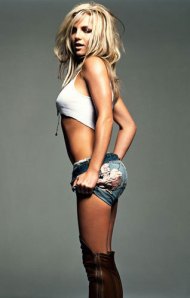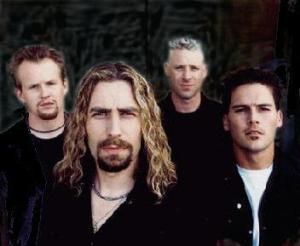
Women in music: the lost generation
August 9, 2010If you spend any time at all listening to apologists for the music industry, you will hear (over and over again) two primary justifications for its existence: i) that they find and nurture talent and ii) that it’s the only way for artists to reach the top tier of music stardom.
So, here are some of the top-selling female artists:
And here are some of the top male artists:
Notice anything?
It’s abundantly clear what the critical criterion is for female super-stardom. And just as clear that the same criterion is not applied to men. The music industry might like to think of itself as nurturing talent, but in reality, it’s a gatekeeper – among other criteria, it keeps women (but not men) who aren’t in the 99th percentile of attractiveness, and willing to exploit it as much as they can, out of the Top 40.
This asymmetry between men and women can be traced to the launch of MTV in 1981 and the rise of visual culture in music. Think about female musicians in the 1960s and 1970s – Joan Baez, Janis Joplin, Carole King – all attractive, certainly, but there wasn’t the marked differential between male and female musicians that is on display in the images above. I mark the start of the double standard for male and female artists—and therefore the start of the ‘lost generation’ of female artists—with the band Yazoo (Yaz in the United States). Yazoo featured Alison Moyet’s fantastic singing backed with songwriting by Vince Clarke (formerly of Depeche Mode, and who later founded Erasure). They released two brilliant albums in 1981 and 1982 before disbanding: Upstairs at Eric’s and You and Me Both, which hit #2 and #1 in the UK, respectively, but barely cracked the top 100 in the US. (You and Me Both eventually went platinum in the US, seven years after its release.) Here’s a promo video that their UK label, Mute, released for Yazoo’s first single, “Only You.”
It’s plausible that Yaz’s relative lack of success in the US stemmed from Alison Moyet not conforming to ideals of female beauty at the exact moment (within a year of MTV’s launch) when the music industry decided it mattered.
One of the reasons why I’m excited about the increasing ability of musicians to interact directly with their fans is because it heralds the end of this type of gatekeeping for female artists. Perhaps optimistically, I think that the event marking the end of the lost generation of female artists is the Belly Incident. Boston artist Amanda Palmer chose to break with her label, Roadrunner Records, and strike out on her own, and a major contributor to that decision was Roadrunner’s insistence that the video for “Leeds United” (at top of post) be re-edited to remove a shot of her bare belly which didn’t conform to their ideals of taut, airbrushed perfection. Palmer’s fans rallied in her defense, posting photographs of their own stomachs in Belly Solidarity, and in the end, the original edit stood.
I’m not arguing that the physical appearance of performers is unimportant—it is, and until our society changes pretty drastically, it will continue to be more important for women than for men. But now that the music industry no longer completely controls the distribution channel for music and who has access to it, people like me and you can hear more music by awesome, creative, challenging, talented, compelling female artists—without requiring them to also look like they’ve stepped out of a record executive’s sexual fantasies.
MP3: Amanda Palmer – Do You Swear To Tell The Truth The Whole Truth And Nothing But The Truth So Help Your Black Ass [why, and buy]










I’d like to think that appearance and age will be less of a factor now, but I’m not so sure that the fans themselves and other musicians have eliminated biases. The current generation of commercial pop female stars are definitely of a certain type — commercially pretty– so there is a sameness about them.
But I have heard negative comments about female singers’ appearance from other musicians. And with YouTube now a big music promotion tool even among DIY artists, visuals still have an impact.
So I think female musicians, like women in US society as a whole, will continue to be defined by their looks.
Thanks for your comment, Suzanne.
I think that you’re absolutely right – that what you look like is as important as ever. And that music reflects the tastes and biases of the public.
But I submit that the tastes of the public–that is, real people who love and are spending money on music–are much broader than the music companies give them credit for. Palmer’s unairbrushed punk aesthetic is a good example. From the point of view of a fan, I like the possibility of being exposed to artists with more distinct aesthetics, rather than being limited to artists that are conventional enough to appeal to a wide range of people.
Lady Gaga, incidentally, is an interesting case because she successfully straddles the ‘arty’ and the conventionally attractive.
One of the reasons I have been rooting for Susan Boyle is that she doesn’t fit the mold of today’s pop star.
And luckily some genres (e.g., blues, jazz, cabaret) are far more about musical skills than looks and youth.
Thanks for posting the AFP video in such a thought-provoking way. I enjoyed this post, and it really got me thinking. It is kind of telling when you line up the pics of current female pop stars, even ones some of us tend to associate with integrity, alongside ones of male stars just looking like average dudes going about their business.
Perhaps it’s the same old question of nudity versus content. Though I do feel both can co-exist harmoniously, it does seem evident the female stars are portrayed showing a heck of a lot more flesh. Kind of alarming…the phrase “pimped out” comes to mind.
I saw the new Katy Perry album at Starbucks, and was kind of shocked. Her pose on the cover is virtually pornographic, and it’s called “Teenage Dream”. Talk about hard selling the sex angle! I thought, “Wow, are we really as a society still so focused on this?” But I appreciated your reminder that that might just be some record exec’s fantasy forced onto the masses. Horrifying to think that message, of what it takes to be a megastar, is what still hits young girls and women thinking of and/or pursuing the path of being a musician. It can be daunting.
Then again, I believe Keith Richards once said Rock and roll should start from the neck down.
A friend and I were recently discussing Lady Gaga, after I saw her and was surprised at some of the overt sexual content, and my (male) friend offered that she’s just young and knows she’s hot and is expressing her sexuality. I’d love to believe that all these female stars were just genuinely expressing themselves, but we all know there’s more to it. There is pressure to conform to a body type. Remember Karen Carpenter?
For the record, I was rather impressed by Lady Gaga’s show. Cool sets (with signs that got you thinking), a live band with several members and interesting instrumentation, real musical talent, and a real human being with a healthy body weight behind it all. She looked healthy, actually, and it made me happy to see her up there doing her thing.
BTW, Sharon Jones is an excellent example of someone who doesn’t fit the conventional mold who is finally now really getting her proper due.
Thanks for your thoughtful response, Ajda.
I do think that Gaga is an interesting edge case; by all accounts, she’s someone who is in creative control of her career, both musically and in terms of its visual aesthetic, and she uses her body as the marketable asset that it is.
[…] zed equals zee « SXSW Interactive 2011: music panels worth checking out Women, digital distribution, and visual image August 26, 2010 Another crosspost, this one from Music Think Tank Open; it was written as a companion to the zed equals zee post, “Women in Music: the lost generation.” […]
What about Tina Turner? She predated Beyonce with the long hair, short skirts, back in the 60s and 70s.